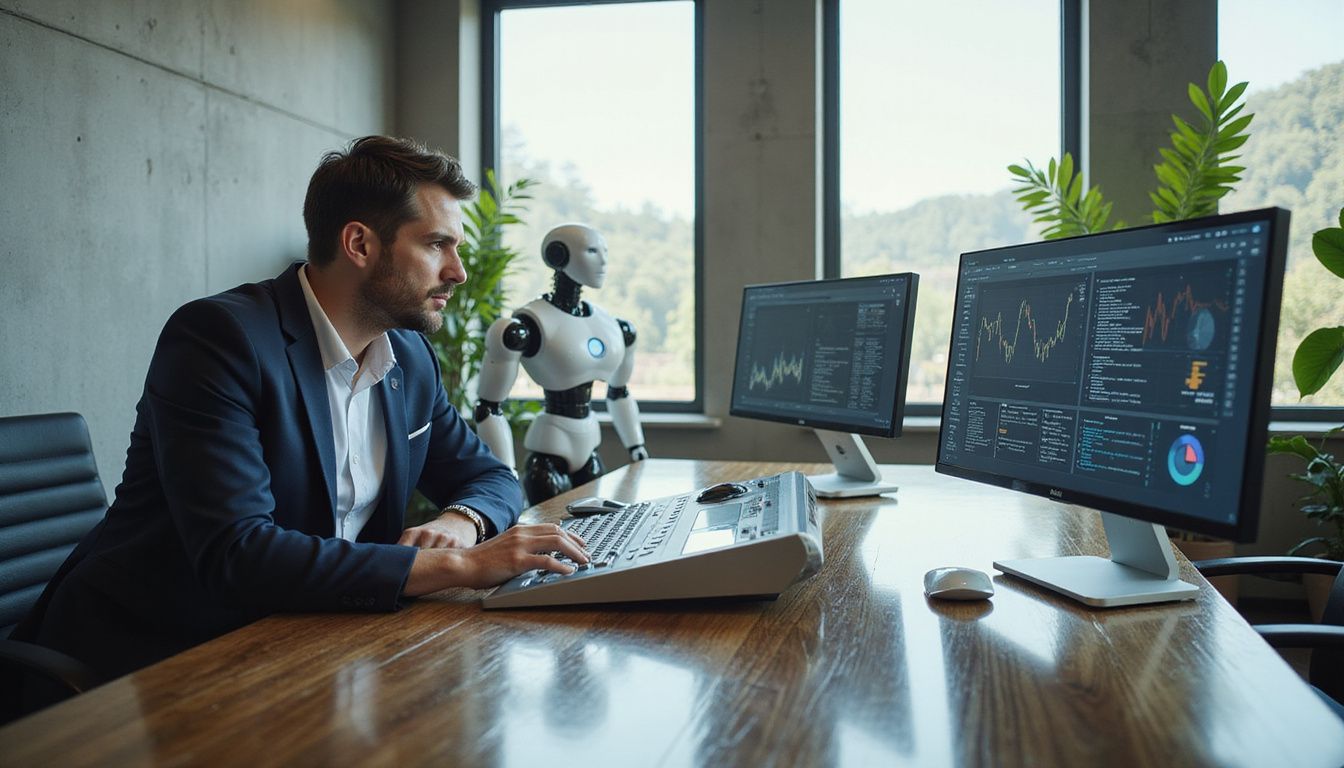Many of us feel a bit lost when digital transformation moves so quickly. We have felt this ourselves, and recent reports show that artificial intelligence now stands at the heart of change for most companies.
Our research points to top trends such as machine learning, edge computing, and improved user experience tools that will shape 2025. Keep reading if you would like to stay ahead in business technology.
Key Drivers of Digital Transformation in 2025

Customer expectations are changing fast. People want quick, personalised services that fit their needs.
AI and automation will drive changes too. More businesses will adopt these tools to boost efficiency and improve customer experiences.
Evolving customer expectations

People want more from digital services now. They expect quick replies, custom offers, and no hassle across all platforms. Brands like Netflix, Nike SNKRS app, and Starbucks AI keep raising the bar by using artificial intelligence to serve us better.
In 2024, banks started offering seamless omnichannel customer experiences. Most retail CIOs plan to use artificial intelligence by 2026 for even quicker responses.
We use CRM software and Digital Experience Platforms (DXPs) to boost retention and Net Promoter Score (NPS). Data analytics tools help us understand what people want in real time. “Success depends on customer-centricity,” is something we hear often at Adobe Systems and Amazon.
Retailers now roll out loyalty apps with increased personalisation while companies like Jatagan Security improved productivity by over 50 per cent through automation solutions such as robotic process automation (RPA).
These changes show that meeting expectations needs constant innovation in business processes and application development.
- Changing customer expectations
- Rapid adoption of artificial intelligence (ai) and generative ai
- Enhanced focus on cybersecurity solutions and sustainability
Accelerated adoption of AI and automation

We see artificial intelligence and automation moving faster than ever. Over 95% of companies plan to invest in AI, according to Broadridge in 2024. Generative AI agents cut software modernisation time by up to half and reduce delivery costs by 40%.
These systems help scale digital transformations and bring double-digit productivity gains within six months, especially in insurance claims processing, factory scheduling, and automating logistics.
Robotic Process Automation combined with GenAI delivers impressive results—up to 200% return on investment. Adoption has reached 53%.
Physical robots and digital agents now work together on real tasks beyond small experiments. Using these intelligent systems boosts business agility while improving customer engagement across CRMs, e-commerce platforms, supply chains, and enterprise resource planning (ERP) tools.
- High investment in AI and automation for productivity gains
- Robotic process automation (RPA) driving significant return on investment
- Need for improved scalability in cloud platforms
Increasing focus on sustainability

AI and automation are speeding up change for many businesses. At the same time, we now place more focus on sustainability in digital transformation. In 2024, equity investments in energy and sustainability technologies made a strong comeback.
McKinsey’s 2025 outlook shows that ‘future of energy and sustainability technologies’ will shape business strategy.
Machine learning models can help energy and utilities firms reallocate up to 80 percent of capital spending; this supports green goals. AI-powered scheduling boosts productivity by 25 to 30 percent for these sectors as well.
Grid digital twins from companies like Google improve operational efficiency and cut maintenance costs for utility providers, while also helping achieve climate targets. New rules like DORA or Basel III now demand greater transparency in sustainability reporting within finance too.
As customer expectations shift, our agile methods must include compliance with these standards while using cloud-based platforms, Internet of Things devices, predictive analytics tools and enterprise resource planning systems to reach competitive advantage through responsible growth.
- Reallocation of capital spending using machine learning models
- Boost in productivity through AI-powered scheduling
- Implementation of digital twins for cost efficiency and sustainability
- Compliance with regulatory demands
Top Digital Transformation Trends for 2025

In 2025, we can expect big changes in technology. Advanced AI and machine learning will play a huge role in how businesses operate. Edge computing and faster 5G networks will help us process data right where it’s needed.
Blockchain technology will secure our transactions more than ever before. Many companies will use easy coding platforms to build software quickly. Cybersecurity measures will keep our information safe from threats.
We’ll also see digital twins being used to predict outcomes before they happen. Plus, augmented reality and virtual reality technologies will become common tools for everyone, enhancing the way we experience digital content.
- Integration of advanced AI and machine learning techniques
- Use of edge computing and 5G for real-time data processing
- Increased application of blockchain for secure transactions
- Adoption of augmented reality and virtual reality in immersive environments
Advanced AI and Machine Learning integration

AI and machine learning are now central to digital transformation. AI agents handle workflow orchestration and automate repetitive tasks, giving us double-digit productivity gains in just six months.
Many companies still lag behind; Deloitte reports 70 percent of organisations have moved only 30 percent or fewer generative AI experiments into production.
Generative artificial intelligence is reshaping software development, customer engagement, and even recruitment through platforms like HireVue. We use predictive analytics for fraud detection in finance with APIs powering fresh services.
Human–machine interaction keeps evolving through natural interfaces, voice control, and adaptive systems. “Generative AI makes the term ‘digital transformation’ seem obsolete.”
Expansion of Edge Computing and 5G

After exploring advanced artificial intelligence and machine learning integration, we now see how edge computing and 5G help shape digital transformation. In 2024, companies invested heavily in cloud platforms and edge devices to boost speed and control in local environments.
With the rise of industrial IoT, edge AI cameras became a key retail trend by supporting real-time analytics for dynamic pricing on shop floors. This shift supports both large language models at centralised data centres and specific tools used right at the source.
We notice that stronger network capabilities from 5G bring faster data transfer to manufacturing, energy, and retail sites. These upgrades allow us to run predictive maintenance using IoT devices while making customer engagement smarter with targeted advertisements or customised offers instantly.
The combination of scalable architecture from cloud systems with specialised sensors improves operational visibility across sectors such as smart-manufacturing and e-learning platforms.
By integrating cybersecurity solutions into these networks, we better prevent data breaches during day-to-day operations too.
- Faster data transfer and improved real-time analytics
- Enhanced predictive maintenance through IoT devices
- Improved operational visibility in various sectors
Growth of Blockchain and Distributed Ledger Technology

Blockchain and distributed ledger technology are changing many industries fast. In supply chain management, we see companies use blockchains for better tracking and more transparent records.
Banking now uses open banking application programming interfaces and secure blockchain transactions to add trust. Regulatory changes like the European Union’s MiCA rules and new United States stablecoin laws help drive responsible adoption across digital assets.
We also notice more demand for scalable, regulatory-compliant platforms as crypto trading grows in popularity. Distributed ledgers help manage digital IDs using biometrics, making identity checks safer in sectors such as finance and energy.
New compliance solutions called RegTech now use blockchain to reduce risk; Basel III Endgame deadline on 1 July 2025 adds extra pressure on banks to strengthen their asset controls with this technology.
As a result, we use these tools for payments as well as for managing smart contracts, settlements, logistics systems, and energy grids.
- Improved tracking and transparency in supply chains
- Secure transactions through blockchain and open banking APIs
- Enhanced compliance with regulatory frameworks
Increased adoption of Low-Code and No-Code platforms

Low-code and no-code platforms are changing how we work with digital transformation. Tools such as Quixy now let us build applications up to ten times faster than before.
Fenesta used these tools to automate its feasibility processes while Adani Green applied them to track public relations activities.
A recent report shows that 60% of educators rely on artificial intelligence or automation daily by using low-code and no-code technologies.
We cut IT bottlenecks and see productivity jump over fifty per cent in some cases thanks to citizen development.
“Low-code empowers everyone in the business to innovate quickly.”
With easy access to AI agents and predictive analytics, non-technical staff upgrade their skills fast which supports change management across many sectors from education to financial technology.
- Accelerated application development without extensive coding
- Reduction of IT bottlenecks and enhanced productivity
- Increased accessibility for non-technical staff
Enhanced focus on Cybersecurity measures

After we increase our use of low-code and no-code platforms, our need for stronger cybersecurity solutions grows. Artificial intelligence (ai), automation, and the cloud all create more data in emails and legacy systems.
This dark data makes it easier for hackers to break in. In fact, Nishant Doshi from Cyberhaven warns that these risks rise as AI spreads into more business tasks.
We must classify our data well because data is the fuel and AI acts as the engine driving digitalisation forward. Ravi Ithal at Proofpoint DSPM highlights the importance of smart data classification to keep sensitive files safe.
New laws like DORA in finance from 17 January 2025 make security audits a strict rule, not just good practice. Atticus Tysen from Intuit urges us to train staff about new threats like deepfakes and phishing scams caused by generative AI tools or chatbot tricks.
We also face demands for clearer accountability and fairness with customer relationship management (CRM) systems powered by machine learning or predictive analytics.
- Need for robust data classification techniques
- Implementation of regular security audits and staff training
- Strengthening systems against phishing, deepfakes, and other threats
Rise of Digital Twins for predictive analysis

We see digital twins changing how we use predictive analytics in many industries. In manufacturing, AI-powered digital twins help us cut costs by up to 50%. Daikin Industries uses them for better asset management and scenario modelling.
Manufacturing firms report that smart tech such as digital twins supports staff retention and upskilling; 94% have seen benefits so far.
In energy and utilities, grid digital twins bring a big jump in productivity with AI scheduling, reaching gains of 25 to 30%. Cloud integration gives us improved visibility, control, and better compliance across systems.
We can reallocate up to 80% of capital expenses more effectively. Digital twins allow real-time monitoring, predictive maintenance using data analytics, and even support healthcare with predictive diagnostics or logistics tracking through the Internet of Things (IoT).
- Substantial cost reduction in manufacturing through digital twins
- Enhanced asset management and scenario modelling
- Empowered predictive maintenance and real-time monitoring
Personalised Digital Experience Platforms (DXPs)

Personalised Digital Experience Platforms, or DXPs, use artificial intelligence and data analytics to boost customer satisfaction. Companies like Starbucks lead with AI-driven personalisation in their apps.
Nike’s SNKRS app is another great example of using digital experience platforms for smart rewards and customer loyalty. Retailers use these tools to improve engagement through CRM systems and predictive analytics.
We focus on user experience (UX) because it links directly to higher sales growth and stronger Net Promoter Scores (NPS). CIOs demand scalable architecture for retail to handle growing customer needs across channels.
Digital twins help us simulate updates before rolling them out on our platforms. Omnichannel banking also uses DXPs to deliver seamless experiences that keep customers coming back.
Data from 2024 shows that companies with strong digital strategies outperform competitors by up to 30 percent in retention rates according to recent analytics reports from Adobe’s research teams.
- Enhanced customer satisfaction through AI-driven personalisation
- Improved user experience and higher retention rates
- Seamless integration across multiple channels
Mainstream adoption of AR/VR technologies

AR and VR technologies are becoming common in many areas. We see a huge growth rate of 44% each year until 2028. Schools use these tools to improve learning, with studies showing that they can boost student retention by 15 to 20%.
Educators increasingly rely on AI, AR, VR, or similar tools daily; about 60% do so.
In manufacturing, these technologies enhance training and provide better interaction. They help create more immersive experiences for workers and customers alike. Audi uses digital showrooms powered by AR/VR to offer new customer experiences.
Retail and entertainment industries are embracing this change too, providing innovative digital experiences that attract more visitors.
- Significant yearly growth in AR/VR adoption
- Boost in student retention and enhanced training methods
- Creation of immersive environments in retail and manufacturing
Industry-Specific Digital Transformation Trends

In healthcare, we see AI helping doctors with faster diagnoses. In banking, secure transactions now use blockchain technology for safety. Retail shops are using smart systems to better understand what customers want.
Meanwhile, manufacturing is all about automation and connecting machines through IoT. Education is changing too, with online learning platforms and AI tutors making study easier for everyone.
Healthcare: AI-powered diagnostics and telemedicine

AI-powered diagnostics are transforming healthcare for the better. We can now read images and make diagnoses 85% faster. This speed assists doctors in treating patients more quickly and accurately.
Telemedicine enables us to consult with healthcare providers from home. Remote healthcare delivery is expanding, making it easier for everyone to access medical help.
Robotic Process Automation (RPA) has reduced administrative costs by 92%. This minimises errors and saves time for healthcare workers. Interoperability of Electronic Health Records (EHR) means we can access patient data seamlessly across different systems.
AI integration with digital twins helps us predict health issues early, improving outcomes significantly. These advancements enhance productivity and save money in the healthcare sector.
Banking: Blockchain for secure transactions

Blockchain stands out as a key tool in banking for secure transactions. It helps ensure safe and quick settlements. Many financial firms increased their spending on blockchain and AI technology in 2024.
This investment aims to enhance transaction security while fostering trust.
New regulations like DORA compliance starting from 17 January 2025 push banks to focus on customer outcomes. Open banking APIs enable innovative products while safeguarding data. AI-powered fraud detection systems are also gaining traction, further improving security measures within the sector.
These trends show how important blockchain is for creating secure banking experiences.
Retail: Smart supply chains and personalised shopping
Retailers are transforming their supply chains to be smarter and more efficient. We see increased use of the Internet of Things (IoT) and data analytics in these systems. This shift helps us track inventory in real time, reduce waste, and meet customer needs faster.
Personalised shopping is becoming essential for capturing sales. Many retailers invest in loyalty apps and single sign-on (SSO) features to enhance customer experience. By 2028, a significant number of US retail stores may close due to digital transformation shifts.
The majority of retail CIOs plan to implement AI solutions by 2026, making personalised experiences key for staying competitive. Next, we will explore specific trends in various industries related to digital transformation.
- Enhanced supply chain efficiency through IoT and data analytics
- Focus on personalised shopping experiences for customer engagement
- Increased adoption of AI solutions in retail
Manufacturing: Automation and IoT integration
Automation and IoT integration are changing how we manufacture products. Smart technology helps us monitor machines in real time. This means we can predict when a machine might fail before it actually does.
As a result, we save time and reduce costs.
94% of manufacturing firms say smart tech helps keep workers engaged and skilled. For instance, Daikin Industries cut their costs by 50% with digital changes. We expect software spending in our sector to grow by over 10% in 2025.
Using AI for scheduling boosts productivity significantly as well; it allows us to allocate resources better while enhancing compliance and visibility through cloud adoption.
- Real-time machine monitoring and predictive maintenance
- Cost reduction and increased worker engagement
- Growth in software spending driven by digital transformation
Education: Virtual learning platforms and AI tutors
Virtual learning platforms are changing education. Many of us now rely on these tools for teaching and learning. AI tutors help improve educational outcomes too. Sixty per cent of educators use AI or automation tools every day in their work.
This makes tasks easier, from grading to managing classrooms.
AI-powered grading systems can cut marking time by 80%. We also see a rise in online courses, making learning more accessible. Predictive analytics helps identify at-risk students, allowing for personalised support.
Virtual reality and augmented reality labs boost student retention by 15 to 20%. Upskilling and digital literacy are essential as we adapt to new methods like robotic process automation (RPA) and data analytics in education.
Next up is how different industries face their own digital transformation trends.
- Expansion of virtual learning and AI tutoring systems
- Reduction in grading time and improved student support
- Enhanced accessibility through online courses
Preparing for Digital Transformation Success

To achieve success in digital transformation, we need to invest in our teams. Upskilling staff is vital for using AI and managing data well. Building strong IT systems gives us the support we need.
It helps everyone adapt and create new ideas.
Upskilling employees for AI and data governance
Upskilling employees is vital for AI and data governance. CIOs prioritise this effort in 2025. We can enhance our workforce by providing micro-credentials during training sessions.
Coherent Solutions suggests aiming for a 70% uptake of new skills through these methods.
Access to AI and knowledge management must be democratised. This will help us bridge the AI skills gap. Stronger data policies are essential to improve accuracy and security as we adopt more cybersecurity solutions.
Training in safety and trust also addresses threats like deepfakes, making our teams better prepared for future challenges. In sectors such as manufacturing, where 94% say smart tech aids retention, upskilling is crucial for success.
- Provision of micro-credentials and continuous learning programmes
- Bridging the AI skills gap through accessible training
- Enhanced data governance and security policies
Investing in robust IT infrastructure
We must focus on investing in strong IT infrastructure. This is key for our digital transformation journey. Significant investments in 2024 highlight the need for cloud and edge computing.
These technologies support AI development, making it essential to improve application performance.
Many workloads can benefit from new semiconductors designed for AI processing. We should also consider compliance with changing regulations; our systems must adapt quickly. Our investment should aim at resilience and scalability to meet future needs.
Challenges like power constraints and skills shortages are real hurdles, but we can overcome them by building a solid foundation now.
- Investment in cloud and edge computing infrastructure
- Improved application performance with new AI processing semiconductors
- Adapting systems for regulatory compliance and future scalability
Building a culture of innovation and adaptability
A culture of innovation is vital for digital transformation. It drives creativity and problem solving. We must encourage our teams to explore new ideas. This helps us adapt quickly to change.
Only 30% of digital transformation projects succeed due to poor strategies and lack of commitment. Thus, a strong focus on transformational leadership is essential.
Cross-functional collaboration plays a key role in shaping this culture. Fusion teams can test new concepts effectively. Continuous innovation boosts our long-term success; companies with strong capabilities see a 14% market-cap premium from their efforts in digitalisation and adaptability plans.
By enhancing employees’ skills for AI readiness, we can harness the power of artificial intelligence and advanced technologies alike, supporting our journey towards effective growth and adaptation.
- Promotion of cross-functional collaboration and fusion teams
- Emphasis on transformational leadership and continuous innovation
- Encouragement of a proactive mindset in adopting change
Common Challenges in Digital Transformation

Change can be tough for many organisations. People may resist new ideas and ways of working. Protecting data while following rules is tricky too. There’s also a shortage of skills in AI and data management.
These issues can slow us down on our journey to digital transformation. Want to learn more about these challenges?
Resistance to change within organisations
Resistance to change affects many organisations. About 70% of digital transformation projects fail because of this issue. Common reasons include poor strategies and weak change management.
A business-as-usual mindset often blocks progress, especially in industries like manufacturing and healthcare.
Cultural barriers also play a role. One-third of companies miss their return on investment (ROI) targets due to these issues. To overcome resistance, we must build a culture that embraces innovation and involves all stakeholders.
Strong change management is key for successful digital transformation initiatives, particularly those using artificial intelligence or machine learning technologies.
- Resistance from traditional mindsets and established routines
- Need for improved change management strategies
- Importance of cultural alignment in transformation projects
Managing data privacy and compliance
Managing data privacy and compliance is a major task for us. We face increasing demands from regulations like DORA, Basel III, and FCA Consumer Duty. These rules press us to ensure transparency and fairness in our digital efforts.
The rise of AI adds to these challenges by exposing risks related to data breaches.
Data debt and dark data make things more complicated. We need to tackle this clutter in emails and older systems. It raises the risk of breaches, especially with AI involved. Our focus must be on strong data classification and governance strategies.
This helps protect against privacy risks while meeting compliance needs effectively. Cybersecurity solutions are crucial here; they support our commitment to maintaining trust in all that we do digitally.
- Increased regulatory demands and data privacy challenges
- Need for effective data classification and governance
- Importance of maintaining transparency and fairness
Addressing the AI skills gap
We face a significant challenge with the AI skills gap. Up to 70% of organisations have only moved 30% or fewer generative AI projects into production due to this issue. Skills shortages in data science, governance, and cybersecurity slow down our digital transformation efforts.
Many industries like manufacturing, retail, and education urgently need upskilling.
CIOs must invest in knowledge management and continuous learning programmes. Micro-credentialing can assist us in gaining new skills quickly. Increased access to AI tools along with low-code and no-code platforms provides a simpler path for many workers to use technology effectively.
Change management is essential; we must support our teams as they adapt to AI-driven work processes. This sets the stage for success in addressing common challenges during digital transformation.
- Significant shortage of AI and technical skills
- Urgent need for continuous learning and development
- Investment in knowledge management programmes
Conclusion

Digital transformation will shape the future. We see trends like advanced AI, edge computing, and blockchain becoming key players by 2025. Each sector will adapt to these changes. Healthcare will use AI for better diagnostics; banking will rely on blockchain for safety.
Staying up-to-date with these trends is vital for success in our digital world.
Disclosure: The data and insights in this article are based on reputable industry reports, including those from Deloitte, McKinsey, and Adobe. The research methodology includes an analysis of public data, statistics, and industry benchmarks. No affiliate relationships have influenced this content.



.svg)










